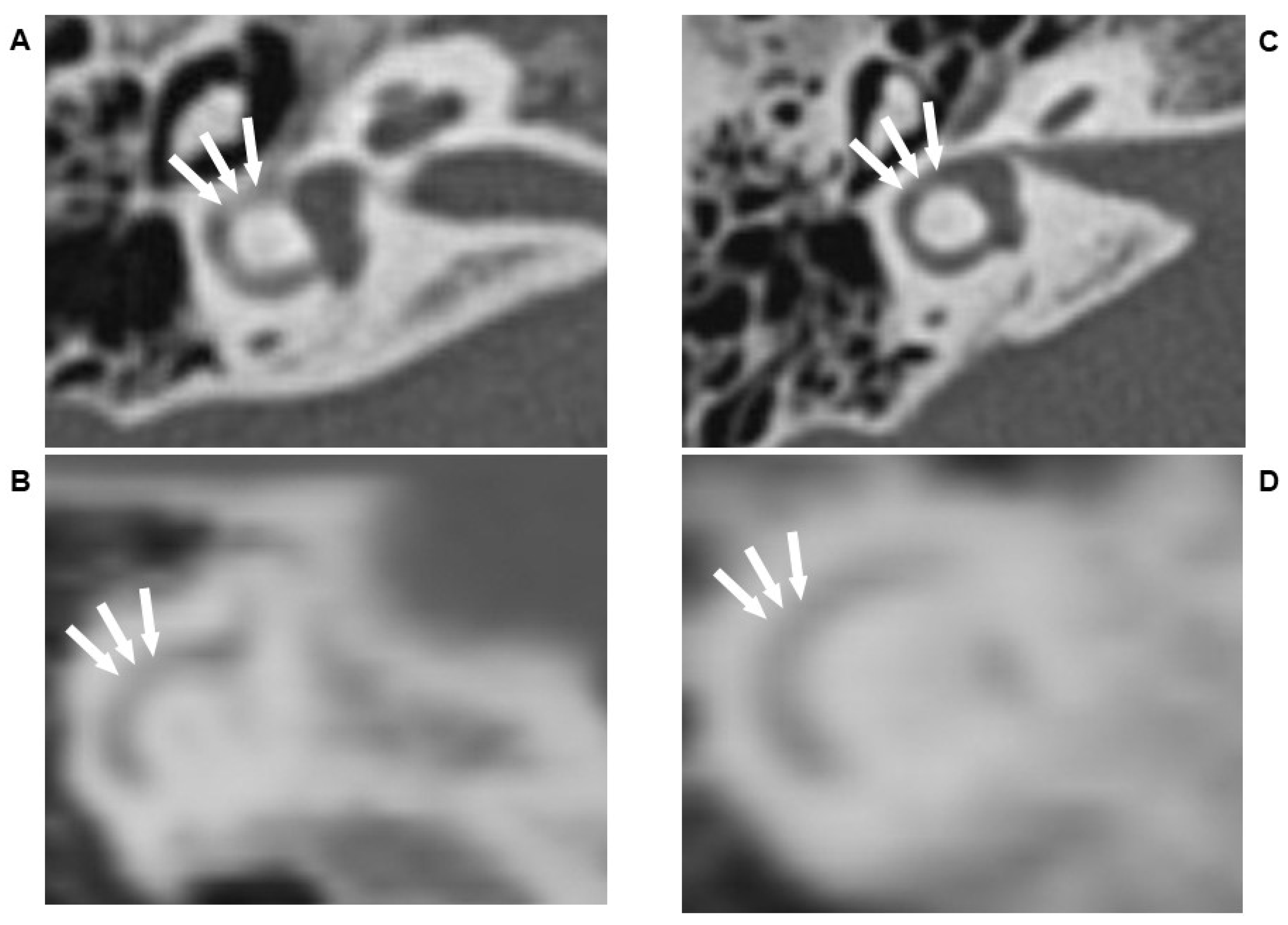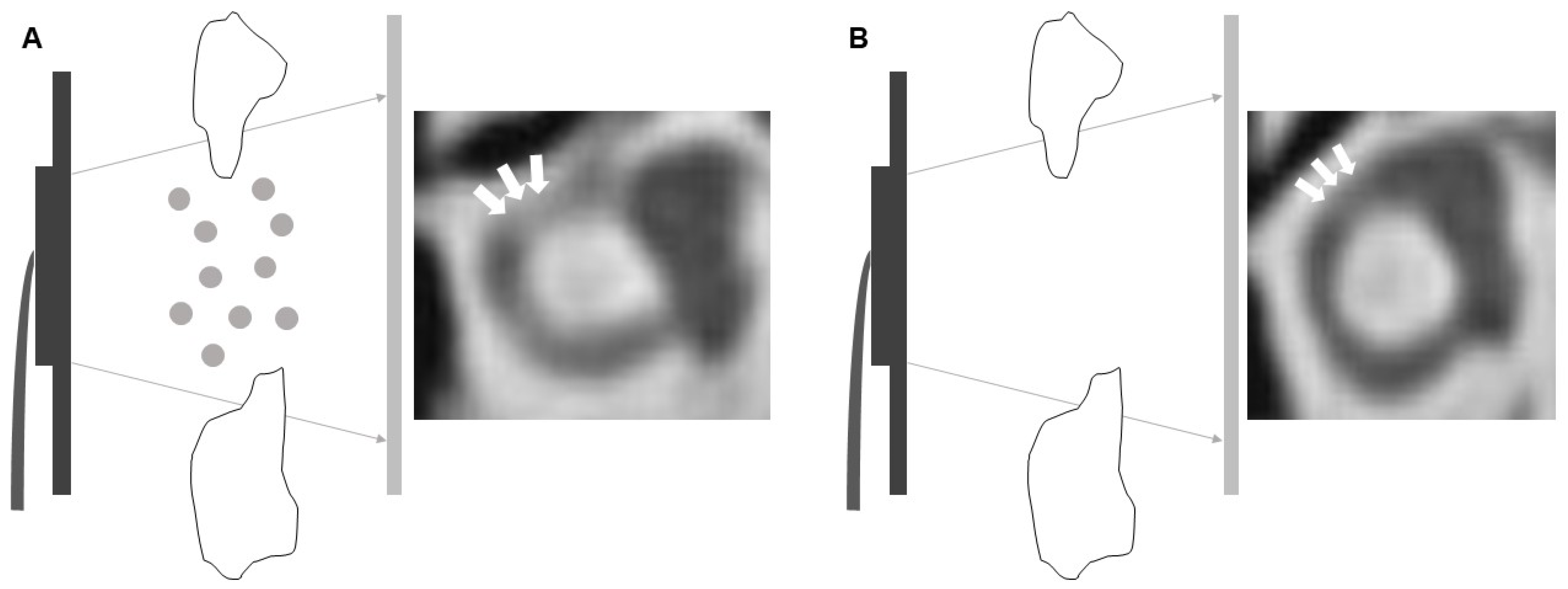The Tyndall Effect in High-Resolution Computed Tomography of Semicircular Canalolithiasis with Benign Paroxysmal Positional Vertigo
Abstract
:1. Introduction
2. Case Reports
3. Discussions
4. Limitations
5. Conclusions
Author Contributions
Funding
Institutional Review Board Statement
Informed Consent Statement
Data Availability Statement
Conflicts of Interest
References
- Dictionaries, C. Collins English Dictionary-Complete & Unabridged, 10th ed.; William Collins Sons & Co.: Glasgow, UK, 2010. [Google Scholar]
- King, M. Management of Tyndall Effect. J. Clin. Aesthet. Dermatol. 2016, 9, E6–E8. [Google Scholar] [PubMed]
- Yao, Q.; Wang, H.; Song, Q.; Shi, H.; Yu, D. Use of the Barany Society criteria to diagnose benign paroxysmal positional vertigo. J. Vestib. Res. 2018, 28, 379–384. [Google Scholar] [CrossRef] [PubMed]
- Cegnar, M.; Miklavzin, A.; Kerc, J. Freeze-drying and release characteristics of polyelectrolyte nanocarriers for the mucosal delivery of ovalbumin. Acta Chim. Slov. 2011, 58, 241–250. [Google Scholar] [PubMed]
- Cai, M.; Wang, Y.; Wang, R.; Li, M.; Zhang, W.; Yu, J.; Hua, R. Antibacterial and antibiofilm activities of chitosan nanoparticles loaded with Ocimum basilicum L. essential oil. Int. J. Biol. Macromol. 2022, 202, 122–129. [Google Scholar] [CrossRef] [PubMed]
- Liu, C.; Kilic, K.; Erdener, S.E.; Boas, D.A.; Postnov, D.D. Choosing a model for laser speckle contrast imaging. Biomed. Opt. Express 2021, 12, 3571–3583. [Google Scholar] [CrossRef]
- Kalume, A.; Wang, C.; Pan, Y.L. Optical-Trapping Laser Techniques for Characterizing Airborne Aerosol Particles and Its Application in Chemical Aerosol Study. Micromachines 2021, 12, 466. [Google Scholar] [CrossRef]
- Bhattacharyya, N.; Baugh, R.F.; Orvidas, L.; Barrs, D.; Bronston, L.J.; Cass, S.; Chalian, A.A.; Desmond, A.L.; Earll, J.M.; Fife, T.D.; et al. Clinical practice guideline: Benign paroxysmal positional vertigo. Otolaryngol. Head Neck Surg. 2008, 139, S47–S81. [Google Scholar] [CrossRef] [PubMed]
- Choung, Y.H.; Shin, Y.R.; Kahng, H.; Park, K.; Choi, S.J. ‘Bow and lean test’ to determine the affected ear of horizontal canal benign paroxysmal positional vertigo. Laryngoscope 2006, 116, 1776–1781. [Google Scholar] [CrossRef] [PubMed]
- Yamane, H.; Konishi, K.; Anniko, M. Visualization of horizontal canal benign paroxysmal positional vertigo using 3DCT imaging and its assessment. Acta Otolaryngol. 2021, 141, 482–489. [Google Scholar] [CrossRef] [PubMed]
- D’Acunto, M.; Cioni, P.; Gabellieri, E.; Presciuttini, G. Exploiting gold nanoparticles for diagnosis and cancer treatments. Nanotechnology 2021, 32, 192001. [Google Scholar] [CrossRef] [PubMed]


Publisher’s Note: MDPI stays neutral with regard to jurisdictional claims in published maps and institutional affiliations. |
© 2022 by the authors. Licensee MDPI, Basel, Switzerland. This article is an open access article distributed under the terms and conditions of the Creative Commons Attribution (CC BY) license (https://creativecommons.org/licenses/by/4.0/).
Share and Cite
Chen, J.-J.; Lui, C.-C.; Chen, T.-Y.; Tseng, P.-T.; Hung, C.-M. The Tyndall Effect in High-Resolution Computed Tomography of Semicircular Canalolithiasis with Benign Paroxysmal Positional Vertigo. Diagnostics 2022, 12, 1000. https://doi.org/10.3390/diagnostics12041000
Chen J-J, Lui C-C, Chen T-Y, Tseng P-T, Hung C-M. The Tyndall Effect in High-Resolution Computed Tomography of Semicircular Canalolithiasis with Benign Paroxysmal Positional Vertigo. Diagnostics. 2022; 12(4):1000. https://doi.org/10.3390/diagnostics12041000
Chicago/Turabian StyleChen, Jiann-Jy, Chun-Chung Lui, Tien-Yu Chen, Ping-Tao Tseng, and Chao-Ming Hung. 2022. "The Tyndall Effect in High-Resolution Computed Tomography of Semicircular Canalolithiasis with Benign Paroxysmal Positional Vertigo" Diagnostics 12, no. 4: 1000. https://doi.org/10.3390/diagnostics12041000
APA StyleChen, J.-J., Lui, C.-C., Chen, T.-Y., Tseng, P.-T., & Hung, C.-M. (2022). The Tyndall Effect in High-Resolution Computed Tomography of Semicircular Canalolithiasis with Benign Paroxysmal Positional Vertigo. Diagnostics, 12(4), 1000. https://doi.org/10.3390/diagnostics12041000





